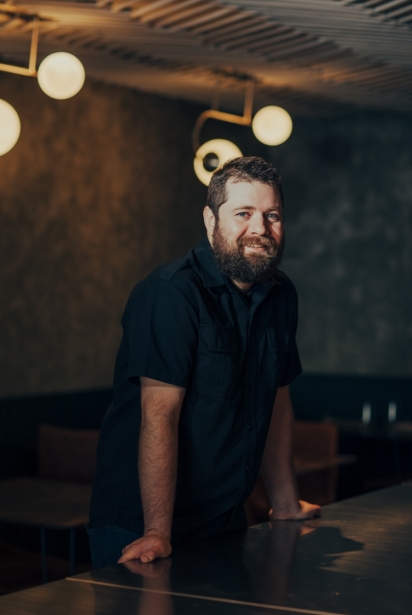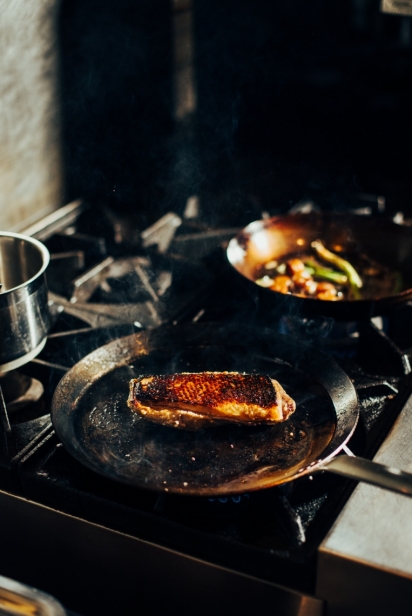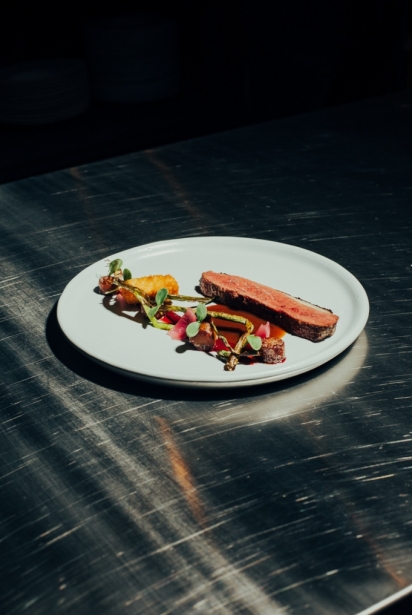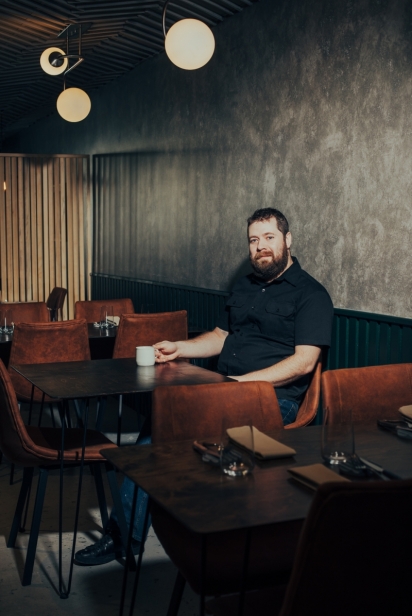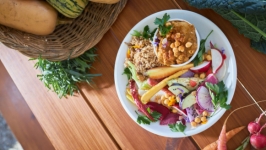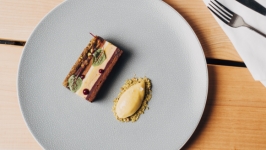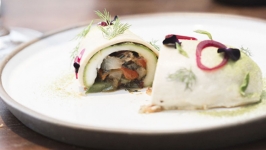Just Outside the Box
Justin Champagne-Lagarde has gone to great lengths to reduce plastic use at his new restaurant.
“I think I’m responsible for at least 10 per cent of climate change, because of all the sous-vide bags I’ve used over the years,” says Champagne-Lagarde, the owner and chef at Perch, a tiny restaurant perched on Preston Street, in the location where Grey Jay took flight before expanding to Echo Drive.
To make up for that, the 34-year-old chef has decided not to use the water-bath technique that sees chefs vacuum-seal all manner of foods in plastic bags and then cook them slowly at a constant temperature in a water bath. It’s a big compromise in fine dining, but he’s found ways to work around it, and he feels good about doing his small part.
His work-around is a small appliance called an Alto Shaam by Halo Heat, which will cook at low heat with lots of humidity. Champagne-Lagarde used it in his submission for The Dish, in which we ask chefs to produce a dish that represents them on a plate and then tell us why.
The dish
The duck dish Champagne-Lagarde prepared is the eighth of nine dishes on his restaurant’s mid-winter tasting menu — a feast that starts with a beet and Pernod emulsion and ends with caramelized parsnip ice cream with chestnut cake and a maple Verjus reduction.
The duck is aged in koji — a fungus grown on rice from spores — wrapped in Atlantic dulse and Pacific kombu and cooked at 60 degrees in the Alto Shaam before being finished with a sear. Disc-shaped potatoes are bathed in a birch syrup and butter confit. There’s caramelized beet, a sauerkraut croquette and charred scallions that snake across the top of the vegetables on the side of the plate. Sprigs of microgreen, brighten things up. A red wine sauce sits in the middle, inviting dipping from all sides.
“It’s based off a dish that my Baba [grandmother in Slovakian] made for Christmas that I absolutely did not like,” Champagne- Lagarde says of his dad’s mom, who he calls a “phenomenal” cook. “My Baba would do whole goose with just an aggressive amount of red wine and there was always sauerkraut involved. I remember I was seven or eight — I can’t remember, but I was young — and it was very aggressive in flavour and I still remember hating it to this day, which is ironic because now, it’s basically all my favourite flavours. I’ve never told [my Baba] that story, but now this dish is based on it.”
He uses duck instead of goose because it’s easier to get, he says.
“Finding nice farms is difficult to begin with, no matter what you’re looking for and everybody’s view on what a good farm is is very different, including farmers. They think they’re doing a really good job and a lot of them are, but sometimes you’d just rather see something a little bit nicer.”
In the winter months, Champagne-Lagarde was getting his produce from Backyard Edibles, Acorn Creek and Juniper Farms. The duck came from Mariposa Farms. The beets were from Juniper and the microgreens were from Backyard Edibles.
“I deal between them, whoever has what at the time because they all fluctuate with what they have available as well,” he says. “Realistically, I probably have between 15 to 20 suppliers. It’s almost a full-time job.”
For eggs, he uses Ferme Thuya, which he says has “phenomenal eggs,” laid by “truly free range, happy chickens.”
Inspiration and influences
Champagne-Lagarde was born and grew up with the last name Lagarde, which is his father’s last name, but he added his mother’s maiden name when he started receiving culinary accolades.
“When I became a chef, I thought to myself, ‘Man, that’s a good last name.'"
Asked about his influences, he names his grandmother, again.
“My Baba was definitely the best cook in my life,” Champagne- Lagarde says, his younger self’s lack of goose and red wine taste notwithstanding. “Her cooking was always incredible — always handmade. She made perogies that were amazing, with plum in them, and she made chicken soup that everyone lined up for.”
His mother says he first asked to go to culinary school when he was five years old, so she enrolled him in a baking class. It didn’t leave much of an impression, however.
“I remember making cookies and that’s it,” he says with a laugh.
He also remembers “almost poisoning” his family when he made cream puffs with a half-cup of salt instead of a half teaspoon.
Champagne-Lagarde says he gets his “modernist touch” from Marc Lepine, the owner and chef at Ottawa’s renowned Atelier, with whom he worked for almost five years.
In Vancouver, he worked for chef Robert Clark, the co-creator of Ocean-Wise, a world-class program that helps businesses and customers identify and purchase sustainable seafood, at C Restaurant.
“It was modern and contemporary,” he remembers.
Finally, he credits San Francisco’s Atelier Crenn, one of the top 50 restaurants in the world and the seventh San Francisco restaurant to earn three Michelin stars. He did an unforgettable two-month stage there.
“That was incredible and huge,” he says. “I think it changed the way I look at food a little bit.”
How the magic happens
Champagne-Lagarde says it’s hard to say exactly how he comes up with his dishes.
“I just get random ideas in my head and then start going,” he says. “I try to be a bit outside the box and to look at food a little differently.”
For example, he doesn’t use any black pepper whatsoever because it’s not meant to be a seasoning.
“It doesn’t enhance flavour, it changes it,” he says.
Nature inspires him as do Canadian ingredients and the landscape. In his bid to be as local as possible, he uses rhubarb and sea buckthorn for acidity in the restaurant, allowing citrus only at the bar.
Above even Canadian ingredients, Champagne-Lagarde puts importance on ethical and sustainable food. That means that if a New Zealand product is raised, fished or harvested more sustainably and ethically than a Canadian product, he’ll go with the New Zealand product in the hopes that Canadian producers will take note, and start to aim for those ideals more often. Or, perhaps governments will realize the need and do a better job of funding such initiatives in Canada.
“There are subsidies in general, but the government could be helping a lot more,” he says. “And [with regulation,] it’s kind of crazy that wild meat has to be farmed. Fogo Island does amazing things, so I use them a lot. I try to deal with the farmers or the fishery directly every single time.”
A colourful background
After high school, Champagne-Lagarde, who grew up in Winnipeg, says he “dropped out of” the University of Manitoba and then Concordia University, after which he started building fish-tanks for a living before moving to Lake Louise and then to Winnipeg to work in a restaurant. The latter wasn’t a big leap since his dad had owned a restaurant for much of his upbringing.
“He had a pizza joint when I was two or three and there are stories of me sitting on the counter eating olives,” he says.
He moved from Winnipeg to Vancouver and applied to work with Robert Clark at C Restaurant, and was turned down.
“I went back and said ‘I’ll be your dishwater’ and they gave me a cook position,” he says. “It was the hardest time of my life in this industry. I was so green. I didn’t know anything. I knew how to cut, but we’re talking about one of the best restaurants in the country at the time, with one of the best chefs in the country. I got my ass kicked every night. I would go to bed so tired and then I would go back to the restaurant the next day at 11 a.m. and wouldn’t leave till 1 a.m.”
After that, he applied and was accepted into the Northwest Culinary Academy of North Vancouver.
“It was four months, really intensive,” he says. “To me, it’s the best way to do culinary school. I loved my school, met a lot of great people, a lot of great chefs who are still pushing hard.”
After school, he joined the opening team at Vancouver’s reputed Hawksworth restaurant after which he did his stage at Atelier Crenn.
“It was such a different way to run a restaurant,” he says. “It was calm, probably the easiest kitchen I’d ever worked in. It was so well organized, so nice. Everyone knew what they were doing. It was still stressful, but when you have a team that’s so well oiled, it’s a completely different kind of grind.”
After Atelier Crenn, Champagne-Lagarde ended up moving to Ottawa with a former partner and he started working at Courtyard Restaurant. The chef there suggested he go to Atelier, which he did, as a cook. Five years later, when he left, he was the sous-chef. After Atelier, he went to Montreal for a job at Restaurant Pastel, which was delayed in opening so he worked in a café until he received a call from Bar Lupulus. “They gave me an offer I couldn’t refuse.”
A place to perch
The name for the restaurant came into his head when he was walking his dog.
“I started with Ellipses — I use three dots a lot when I text and I like that it kind of means ‘more to come,’ but one of the original [potential] investors said people wouldn’t know how to spell it, wouldn’t find it on Google and wouldn’t know what it meant,” he says. “Then I thought of Bloom, because we had been considering more of a café and coffee comes to bloom, koji comes to bloom, but I didn’t like that enough. It’s a little bit too generic. Then Perch came to me.”
He liked the idea that perch is a local, delicious fish; that people will be perched by his completely open-concept kitchen and that Gray Jay — a bird — was perched there before it flew off to a bigger space.
In its pure, non-COVID-restricted form, Perch’s dining room has a series of tables along one wall, across from the kitchen, that are occupied by those who want the nightly tasting menu. A couple more tables in the front of the restaurant, along with a few at a raised bar, form “the lounge” and are open to à la carte dining.
“I wanted to take Atelier and Lupulus and mash them together a bit,” says Champagne-Lagarde, who runs Perch with his life partner, Amanda MacIntosh, who serves as general manager.
Joining Champagne-Lagarde in the kitchen for the four nights a week the restaurant operates are Tu Le, who cooked at MēNa and was the opening pastry chef at Aiāna, and Nikita Panov, who is studying food science and has worked at Beckta and Pelican Grill.
There’s a bartender (who is a professional tenor as well) and a sommelier, but there aren’t dedicated servers. The chef or the cooks take most of the food to the tables.
“We also do a complete tip-out — all staff, kitchen included,” he says. “I don’t take any of it because I own the place. I feel like the tipping situation has been an issue for a very long time so we’re trying to find something that’s fair.”
Also fair is the fact that he pays more than minimum wage, so there wasn’t any sticker shock when minimum wage went up in January 2022.
Of the future, Champagne-Lagarde says he has no retirement plan because “I own a restaurant.” But he does have visions of co-owning a bed and breakfast in Spain with another chef friend and trading off operating responsibilities for six months at a time. “That sounds like fun,” he says, laughing, and clearly understanding that’s a ways off yet.
Perch Restaurant and Lounge
300 Preston St., Ottawa, Ont.
perchottawa.ca | 613.515.0535



